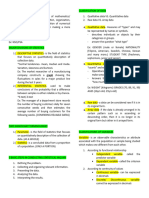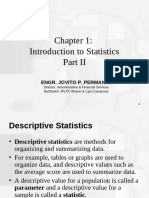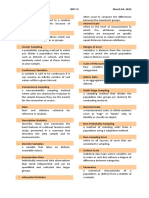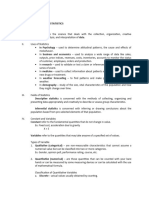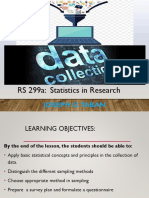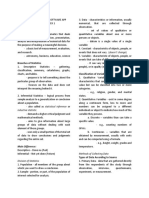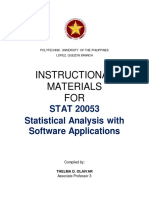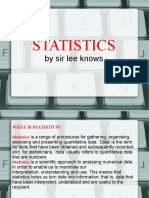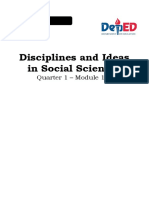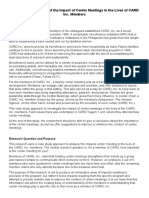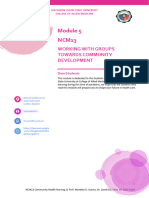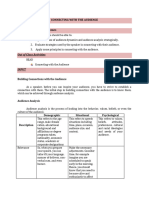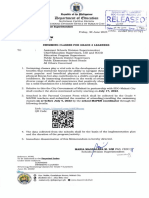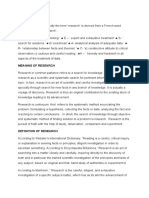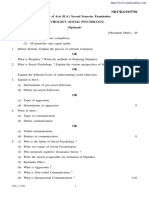Pamaran, Kristel Denish PSYCHOLOGICAL STATISTICS
BSP 1-F
MINI DICTIONARY
1. STATISTICS - Refers to a set of mathematical procedures for organizing, summarizing, and
interpreting information. It consists of facts and figures such as average income, crime rate,
birth rate, average snowfall, and so on. It is a scientific body of knowledge that deals with the
collection, organization, and interpretation of data.
2. POPULATION - The set of all the individuals of interest in a particular study. It is the totality
of the elements from which data under consideration shall be obtained. Refers to a large
collection of objects, persons, places, or things. It is usually denoted or represented by N.
3. PARAMETER - Parameter is usually a numerical value that describes a population. It is any
numerical or nominal characteristic of the population. It is a value or measurement obtained
from the population.
4. STATISTIC - Statistic is usually a numerical value that describes a sample. It is an estimate of
parameter. It is any value or measurement obtained from a sample.
5. VARIABLES - Variables are any characteristics that can take on different values, such as
height, age, temperature, or test scores.
6. DATA - Measurements or observations. Facts or set of information or observation under study.
More specifically, data are gathered by the researcher from a population or from a sample.
7. METRIC DATA - data obtained by measurement.
Examples: height, weight, age, monthly income, performance rating, scores in a test, grades,
length of teaching experience, etc.
8. ENUMERATION DATA - data obtained by counting.
Examples: number of students in a classroom, number of households in a barangay, number of
working students, etc.
9. CATEGORICAL DATA - data which can be classified into groups or categories of
responses. Examples: attitudes, perceptions, personality traits, study habits, socio-economic
status, level of stress, level of implementation.
10. NOMINAL SCALE - A nominal scale consists of a set of categories that have different
names. Measurements on a nominal scale label and categorize observations, but do not make
any quantitative distinctions between observations.
11. ORDINAL SCALE - An ordinal scale consists of a set of categories that are organized in an
ordered sequence. Measurements on an ordinal scale, rank observations in terms of size or
magnitude.
12. INTERVAL SCALE - Interval scale has an arbitrary zero point. The value 0 is assigned to a
particular location on the scale simply as a matter of convenience or reference. In particular, a
value of zero does not indicate a total absence of the variable being measured.
13. RATIO SCALE - Ratio scale is anchored by a zero point that is not arbitrary but rather is a
meaningful value representing none (a complete absence) of the variable being measured.
�14. DESCRIPTIVE STATISTICS - Descriptive statistics are statistical procedures used to
summarize, organize, and simplify data. It is a technique that take the raw score and organize or
summarize them in the form that is more manageable. Generally, descriptive statistics involves
gathering, organizing and presenting, and describing data.
15. INFERENTIAL STATISTICS - Inferential Statistics consist of techniques that allows us to
study samples and then make generalizations about the populations from which they were
selected.
16. SAMPLING ERROR - It is the discrepancy, or amount of error, that exists between a
sample statistic and the corresponding population parameter. It is the error arises as a result of
taking a sample from a population rather than using whole population. The sampling error for a
given sample is unknown but when the sampling is random, the maximum likely size of the
sampling error is called the margin of error.
17. NON-SAMPLING ERROR - The error that arises in data collection process as a result of
factors other than taking a sample. Non sampling error have the potential to cause bias in polls,
surveys, or samples.
18. SAMPLING - Sampling is the process of taking the sample from a population.
19. SAMPLING TECHNIQUE - Sampling technique is the procedure used to determine the
individuals or members of the sample.
20. PROBABILITY SAMPLING - It is a sampling technique wherein each member or element
of the population has an equal chance of being selected as a member of the sample. It is
therefore an assumption that when using a probability sampling, the researcher should have a
complete list of the members of the population.
21. SIMPLE RAMDOM SAMPLING/RAMDOM SAMPLING - It is a technique of drawing
sample whereby each element of the population has an equal chance of being taken into the
sample. This technique is the most commonly used especially if the population is homogenous
with respect to a particular attributes or characteristics.
22. SYSTEMATIC SAMPLING - It is a technique of choosing an element for every k elements
N
of a population where k = , where N is the population size and n is the sample size.
n
Researchers use the systematic sampling method to choose the sample members of a
population at regular intervals. It requires the selection of a starting point for the sample and
sample size that can be repeated at regular intervals. This type of sampling method has a
predefined range, and hence this sampling technique is the least time-consuming.
23. STRATIFIED SAMPLING - It is a technique of dividing a population into groups, called
strata, and sampling is done in each stratum. Stratified random sampling is a method in which
the researcher divides the population into smaller groups that don’t overlap but represent the
entire population. While sampling, these groups can be organized and then draw a sample from
each group separately.
24. CLUSTER SAMPLING - It is a technique of taking a sample from groups, and all the
elements in those group chosen will form the sample. It is a method where the researchers
divide the entire population into sections or clusters that represent a population. Clusters are
identified and included in a sample based on demographic parameters like age, sex, location,
� etc. This makes it very simple for a survey creator to derive effective inference from the
feedback.
25. MULTI-STAGE SAMPLING - Multi-Stage Sampling is a sampling in various stage until the
desired sampling units are obtained. It is used in studies that cover a wide geographical area or
substantially large population.
26. NON-PROBABILITY SAMPLING - It is a sampling technique wherein members of the
sample are drawn from the population based on the judgement of the researcher. The results of
a study using this sampling technique are relatively biased.
27. CONVINIENCE SAMPLING - As the name implies, convenience sampling is used because
of the convenience it offers to the researcher. Although convenience sampling may be used
occasionally, we cannot depend on it in making inferences about a population
28. PURPOSIVE SAMPLING - It is a technique of choosing sampling units from a given
population which have a specific characteristic.
29. SNOWBALL SAMPLING - Snowball sampling is a sampling method that researchers apply
when the subjects are difficult to trace. For example, it will be extremely challenging to survey
shelter less people or illegal immigrants. In such cases, using the snowball theory, researchers
can track a few categories to interview and derive results.
30. QUOTA SAMPLING - A technique of setting a sample size based on the nature of the data
that are needed and taking the first sampling units that fulfill the required number or quota.




